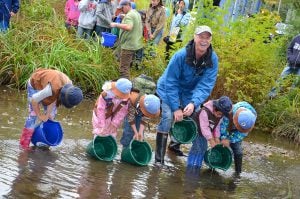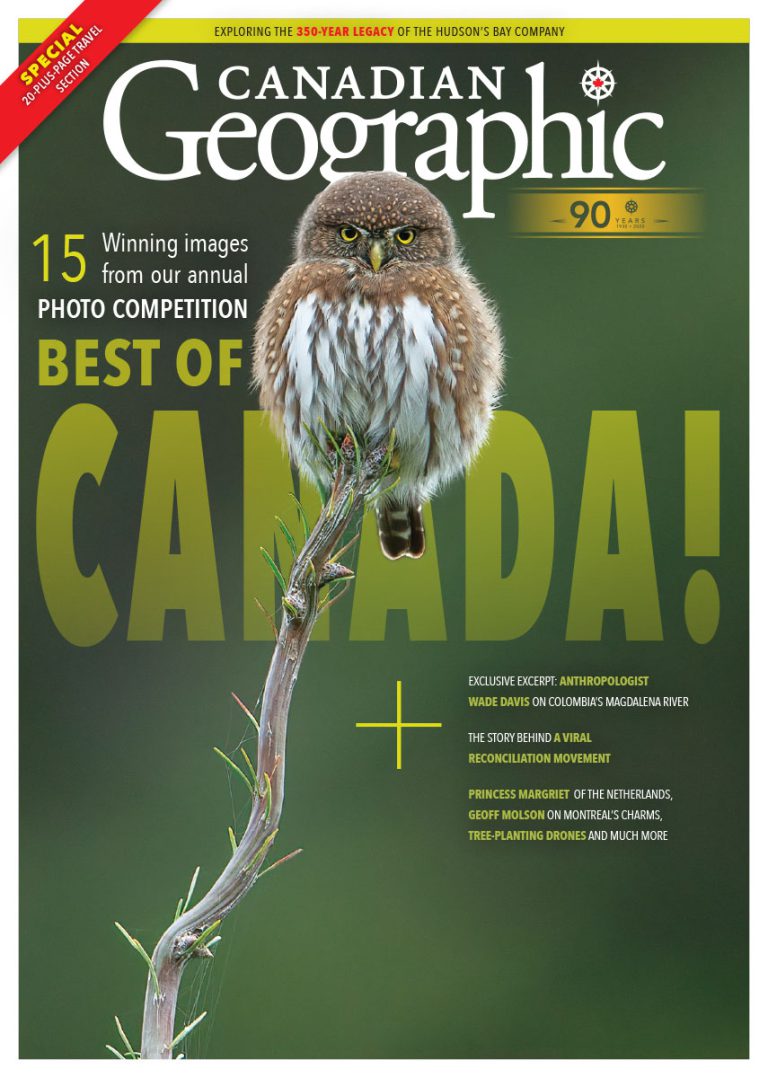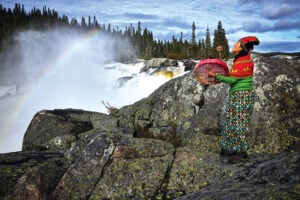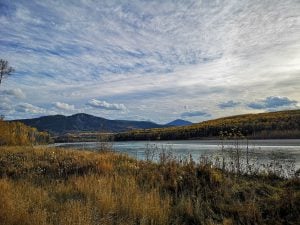The Caribbean sky is the color of dreams, and the clouds appear as shadows on the still surface of Colombia’s Ciénaga Grande de Santa Marta. Our skiff scudded over the water as we left the narrow neck of shoreline behind at Tasajeras. The wetland expanded in every direction. At full throttle, our small party was soon skating over a mirror of glass, with only a distant fringe of mangroves to suggest the presence of horizons and the mundane separation of Earth from sky. The faint silhouette of the Sierra Nevada de Santa Marta hovered about 50 kilometres to the east. As the sun cuts the ice loose from the frozen summits, glacial streams from those heights grow into seasonal rivers — the Fundación, Tucurinca, Aracataca, and Riofrío — that replenish the wetland with fresh water and more essentially, according to the mamos, infuse it with aluna, the generative essence of the Madre Creadora, the Great Mother. Running away from the ciénaga to the south and west are natural canals that ultimately fuse with the floodwaters of the Río Magdalena. Like the arteries and veins in the human body, a network of waterways reaches across the ancient delta to connect the snowfields of the Sierra Nevada, the most sacred destination of the pilgrims, with the river that made possible the life of the Colombian nation.
The mamos still speak of a time when the Ciénaga Grande was wet with the innocence of birth, an aquatic Eden that was home to manatees, jaguars, caimans, and no fewer than 244 species of birds. Open to the Caribbean, recharged by the annual surge of the Magdalena, the wetland was a perfect balance of river and sea. Often described as the most beautiful body of water in Colombia, it was certainly the most productive. Bocachico, bagre, and more than a dozen species of edible fish thrived in the shallows, softening the mangrove roots with their spawn. The fishery was so bountiful that those who stumbled upon it decided to stay. Men from Soledad and Santo Tomás, Sitionuevo, Malambo and all the exhausted fishing settlements of the coast settled first at the mouth of Aguas Negras. All they needed to prosper was at hand: salt, fish and the sun. Their only challenge were the flocks that darkened the sky: cormorants, screaming gulls and egrets that feasted on the catch as it dried. To escape the scavengers, families took to the water, building shelters on pilings that over time grew into floating villages serviced only by canoe and small skiffs. The oldest, Bocas de Aracataca, dates to 1786. The other two, Buena Vista and Nueva Venecia, first known as El Morro, go back at least a century, some say to 1847.
After an hour on the water, tracking the eastern shore of the ciénaga, we slipped through the narrows and came upon Buena Vista, a rather forlorn place that clearly has seen better days. From a near distance, it seems little more than a warren of tired shacks that paint alone keeps from tumbling into the water. Nueva Venecia was altogether different. Laid out in a neat grid, with waterways in place of roads, it’s a lively and exuberant town of two thousand, fishing families for the most part, all living in neat, brightly painted wooden homes with elevated gardens and enclosed pools where they grow fingerlings, fish to replenish the wetlands. The community is serviced by an assortment of bars, tiendas, billiard halls and soccer fields, all perched above the water, save the church, the anchor and sanctuary of the community. It alone occupies solid ground, land built up by hand, a pico y pala, by pick and shovel.
According to our pilot and host, Ahmed Gutiérrez, things began to go wrong in 1955, when the government authorized the construction of a highway along the Caribbean shore. The goal was to shorten the travel time between Santa Marta and Barranquilla by eliminating the long loop south and north around the Ciénaga Grande. With insufficient conduits beneath the roadway to allow for the ebb and flow of water essential to the health of the wetland, the causeway effectively served as a dam, shutting off the sea, to the detriment of all the creatures adapted to live in brackish water. Some 26,000 hectares of mangroves perished, all vital spawning habitat. As the shore took on the aspect of a desert, fish populations collapsed, even as birds fell dead from the sky.
To make matters worse, the natural infusion of fresh water, also essential to the equilibrium of the system, fell dramatically as rivers draining the flank of the Sierra Nevada were diverted to deliver water to the banana and oil palm plantations that, on an industrial scale, consume much of the fertile land surrounding the vast ciénaga. The Río Aracataca, originally 30 metres across and nine deep, was reduced to a heavily sedimented stream just eight metres wide with a depth of a half a metre. In place of glacial flows, cold and pure, the ciénaga increasingly absorbed agricultural runoff tainted with pesticides, nitrogenous fertilizers and herbicides. In time, the salinity of the wetlands surpassed that of the sea. In June 1994, a much degraded Ciénaga Grande earned the terrible distinction as the site of the largest incident of fish mortality in Colombian history.
“It got so bad, you couldn’t touch the water,” Ahmed recalled. “The salt made your skin itch. Cats would swim but dogs became afraid. In some places the whole ciénaga turned red, almost like blood.”
Ahmed had generously offered to put us up, and as his daughter pulled together a simple lunch, we hung our hammocks in a vacant storage area at the back of his home. Our new friend claimed to be 55 but looked 40, with thick black hair and a generous mustache showing not a speckle of grey. As a local merchant, boat owner, onetime mayor and national park guardian with a passion for education and conservation, Ahmed naturally knew everyone in Nueva Venecia. But his style and charm suggested a cool confidence that would have registered in any setting. He acted more like a maître d’ than a small-town politician, radiating a warmth and civic pride that was both sincere and infectious. When Ahmed said the government had done nothing, leaving the people to save both the ciénaga and their town, we took him at his word. He was a man easy to believe.
The good people of Nueva Venecia, Ahmed explained, whose grandparents had built an island by hand to erect a church, had no trouble opening an outlet to channel fresh water from the Magdalena into the wetland. To do so, they simply ignored the government authorities. Still, the main conduits remained obstructed at the caños of Torno, Clarinuevo, Aguas Negras and Renegado.
“But God is wonderful,” Ahmed said with a smile, “and he sent us a great winter!”
Divine intervention took the form of torrents of rain that overwhelmed the floodgates, eroding small gaps that grew into chasms, allowing water from the Magdalena to surge into the wetland. The salutary impact was, according to Ahmed, almost immediate. Within a season, the mangroves began to recover. Fisherman returned at dawn with food for their families. Fathers and mothers struggled to remember stories of manatees, creatures their children had never before seen.
“The ciénaga is so resilient,” Ahmed said in wonder, “just like the people. Forty years ago, no one had power — no ice, radios, outboards, television. Just simple lamps, wick and oil. The entire town was lit with tufts of hair. It was pure poetry at night; rare was the man who was not a poet. Verse after verse in the same sequence, the same rhyme, all the verses carrying the rhyme. There was a chorus to accompany the black dances, and always palm fronds. Without palms, you can’t have a black dance. And without the dance, the town couldn’t survive, because the black dances never end. Poetry and black dancing, that’s what kept the place alive.”
Ahmed had in mind a time when the people of Nueva Venecia still sketched the stories of their lives, asking nothing of the state save to be left alone to feast on bocachico, bagre, and corvina, fish now lost to memory. An era impossibly distant, yet as near as yesterday, the childhood of his own grandfather.
Later that evening, Ahmed introduced us to Armando Martínez, a much admired elder. We found him in a rocker in the corner of his wooden room, flanked by doorways that opened directly to the water. Still spry at 88, Armando appeared to be working out, a sort of calisthenics of goodwill. A gentle wave of his right hand greeted boats and canoes passing one side of his house, while his left acknowledged those coming along the busier channel in front. The traffic at dusk kept him active and clearly content. The sun warmed his face. He had a wonderful profile: bold, proud, and distinguished. After a busy day in his herb garden, he was dressed for the evening, in a white shirt and dark trousers, both neatly pressed. His bare feet were the colour of the floor. The patina made me wonder about the age of the house, and how long mangrove wood lasted as pilings, joists, roof beams and boards. Maintenance was the key, Armando explained. He had been born in the very room where he now sat, as had his father before him. His dad had lived to be 90.
“And we will continue to live,” Armando proclaimed, as if speaking for his lineage. “I certainly intend to continue living. I still do not want to die.”
Excerpted from Magdalena: River of Dreams by Wade Davis. Copyright © 2020 by Wade Davis. Published by Alfred A. Knopf Canada, a division of Penguin Random House Canada Limited. Reproduced by arrangement with the publisher. All rights reserved.





